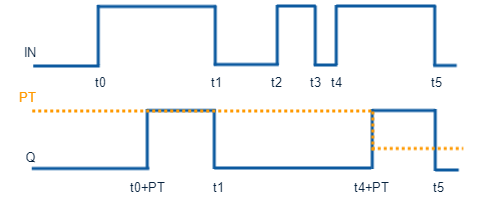uTON block
Short summary
|
Name |
uTON |
|
→POU type |
|
|
Category |
|
|
Conform to →IEC-standard |
|
|
Graphical interface |
|
|
Available since |
version 1.45.0 (for logi.CAD 3) |
Functionality
Similar to the TON block, this is an edge delay where the turning-on edge is delayed. In contrast to TON, the output ET is not provided for uTON.
Enter the delay period at input PT. If input IN is →turned on and the delay period is over, output Q returns value TRUE (or an equivalent). If input PT is changed after input IN has been turned on, the behavior of the block is affected.
This block receives the current system time from the runtime system. This time remains constant while the same task is executed. However, in case of different tasks, it is possible that a different system time is used when the belonging programs are executed (even if the different tasks have the same cycle time).
The following illustration shows the behavior of uTON:

In-/outputs
|
|
Identifier |
Description |
|
|
Inputs : |
IN |
BOOL |
input/start |
|
PT |
TIME |
preset time |
|
|
Outputs : |
Q |
BOOL |
output |
Input EN and output ENO are available when →calling the block. See "Execution control: EN, ENO" for information on input EN and output ENO.
Example for usage within ST-editor
PROGRAM Test VAR uton1 : UTON; elapsed : BOOL; END_VAR uton1(IN := TRUE, PT := T#2s, Q => elapsed); (* Instance of block 'uTON' is called. Variable 'elapsed' is set to TRUE after 2 seconds. *)END_PROGRAM
When creating your application within the ST-editor, enter a call of a block by typing the text as requested by the syntax or use Content Assist.